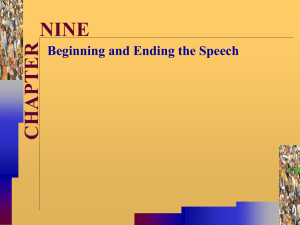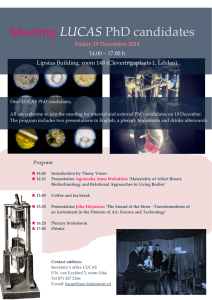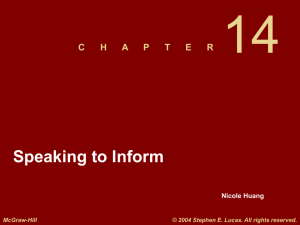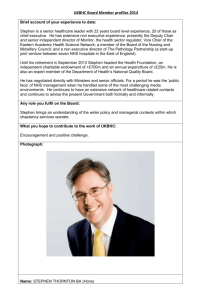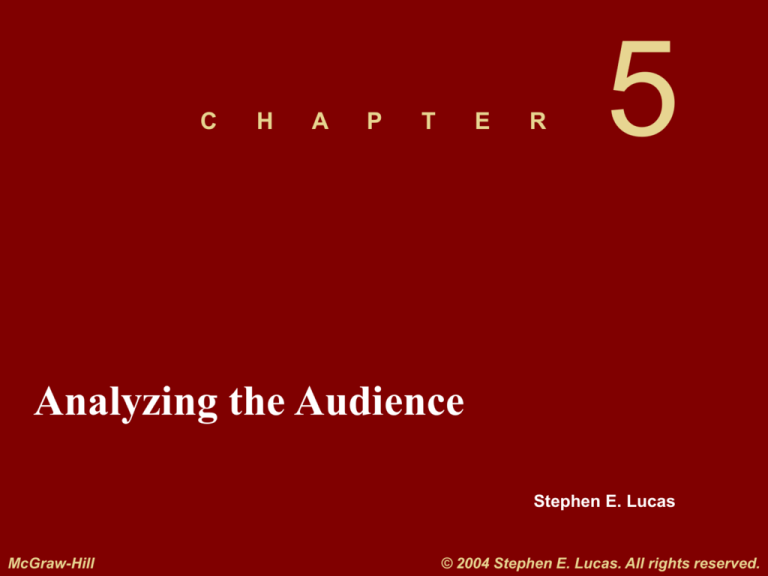
C
H
A
P
T
E
R
5
Analyzing the Audience
Stephen E. Lucas
McGraw-Hill
© 2004 Stephen E. Lucas. All rights reserved.
Slide 2
Audience-Centeredness
Keeping the audience foremost in mind
at every step of speech preparation and
presentation.
McGraw-Hill
© 2004 Stephen E. Lucas. All rights reserved.
Slide 3
Questions for AudienceCenteredness
• To whom am I speaking?
• What do I want them to know, believe,
or do as a result of my speech?
• What is the most effective way of
composing and presenting my speech to
accomplish that aim?
McGraw-Hill
© 2004 Stephen E. Lucas. All rights reserved.
Slide 4
Identification
Creating a bond with listeners by
emphasizing common values, goals, and
experiences.
McGraw-Hill
© 2004 Stephen E. Lucas. All rights reserved.
Slide 5
Egocentrism
The tendency of people to be concerned
above all with their own values, beliefs, and
well-being.
McGraw-Hill
© 2004 Stephen E. Lucas. All rights reserved.
Slide 6
Factors of Demographic
Audience Analysis
•
•
•
•
•
•
McGraw-Hill
Age
Gender
Sexual orientation
Racial, ethnic, and cultural background
Religion
Group membership
© 2004 Stephen E. Lucas. All rights reserved.
Slide 7
Stereotyping
• Creating an oversimplified image
of a particular group of people, usually
by assuming that all members of the
group are alike.
McGraw-Hill
© 2004 Stephen E. Lucas. All rights reserved.
Slide 8
Factors of Situational
Audience Analysis
•
•
•
•
•
McGraw-Hill
Size
Physical setting
Disposition toward the topic
Disposition toward the speaker
Disposition toward the occasion
© 2004 Stephen E. Lucas. All rights reserved.
Slide 9
Attitude
A frame of mind in favor of or opposed to
a person, policy, belief, institution, etc.
McGraw-Hill
© 2004 Stephen E. Lucas. All rights reserved.
Slide 10
Getting Information about
the Audience
• Interviewing
• Questionnaires
McGraw-Hill
© 2004 Stephen E. Lucas. All rights reserved.
Slide 11
Questionnaires
• Fixed-alternative questions
• Scale questions
• Open-ended questions
McGraw-Hill
© 2004 Stephen E. Lucas. All rights reserved.
Slide 12
Fixed-Alternative Questions
Questions that offer a fixed choice between
two or more alternatives.
McGraw-Hill
© 2004 Stephen E. Lucas. All rights reserved.
Slide 13
Fixed-Alternative Question
Have you ever engaged in volunteer work
for a community, religious, or charitable
organization?
Yes______
No_______
McGraw-Hill
© 2004 Stephen E. Lucas. All rights reserved.
Slide 14
Scale Questions
Questions that require responses
at fixed intervals along a scale of answers.
McGraw-Hill
© 2004 Stephen E. Lucas. All rights reserved.
Slide 15
Scale Question
If you have engaged in volunteer work, how
would you rate the experience?
Very
rewarding
McGraw-Hill
Somewhat
rewarding
Neutral
Somewhat
unrewarding
Very
unrewarding
© 2004 Stephen E. Lucas. All rights reserved.
Slide 16
Open-Ended Questions
Questions that allow respondents to answer
however they want.
McGraw-Hill
© 2004 Stephen E. Lucas. All rights reserved.
Slide 17
Open-Ended Question
If you have worked as a volunteer, do
you plan to do so again? Why or why
not?
McGraw-Hill
© 2004 Stephen E. Lucas. All rights reserved.
Slide 18
Using Audience-Analysis
Questionnaires
McGraw-Hill
© 2004 Stephen E. Lucas. All rights reserved.
C
H
A
P
T
E
R
10
Outlining the Speech
Stephen E. Lucas
McGraw-Hill
© 2004 Stephen E. Lucas. All rights reserved.
Slide 20
Preparation Outline
A detailed outline developed during the
process of speech preparation that
includes the title, specific purpose,
central idea, introduction, main points,
subpoints, connectives, conclusion,
and bibliography of a speech.
McGraw-Hill
© 2004 Stephen E. Lucas. All rights reserved.
Slide 21
Guidelines for the
Preparation Outline
• State the specific purpose of your
speech
• Identify the central idea
• Label the introduction, body, and
conclusion
• Use a consistent pattern of
symbolization and indentation
McGraw-Hill
© 2004 Stephen E. Lucas. All rights reserved.
Slide 22
Guidelines for the
Preparation Outline
• State main points and subpoints in
full sentences
• Label transitions, internal summaries,
and internal previews
• Attach a bibliography
• Give your speech a title, if one is
desired
McGraw-Hill
© 2004 Stephen E. Lucas. All rights reserved.
Slide 23
Visual Framework
The pattern of symbolization and
indentation in a speech outline that
shows the relationships among the
ideas of the speech.
McGraw-Hill
© 2004 Stephen E. Lucas. All rights reserved.
Slide 24
Example of Visual
Framework
I. Main point
A. Subpoint
B. Subpoint
1. Sub-subpoint
2. Sub-subpoint
II. Main point
A. Subpoint
1. Sub-subpoint
2. Sub-subpoint
B. Subpoint
McGraw-Hill
© 2004 Stephen E. Lucas. All rights reserved.
Slide 25
Bibliography
A list of all the sources used in
preparing a speech.
McGraw-Hill
© 2004 Stephen E. Lucas. All rights reserved.
Slide 26
Speaking Outline
A brief outline used to jog a
speaker’s memory during the
presentation.
McGraw-Hill
© 2004 Stephen E. Lucas. All rights reserved.
Slide 27
Guidelines for the Speaking
Outline
• Follow the visual framework used in
the preparation outline
• Make sure the outline is plainly
legible
• Keep the outline as brief as possible
• Give yourself cues for delivering the
speech
McGraw-Hill
© 2004 Stephen E. Lucas. All rights reserved.
Slide 28
Delivery cues
Directions in a speaking outline to
help a speaker remember how she
or he wants to deliver key parts of
the speech.
McGraw-Hill
© 2004 Stephen E. Lucas. All rights reserved.

